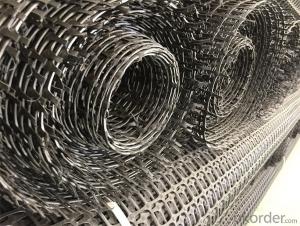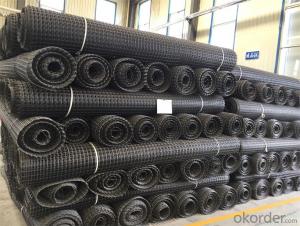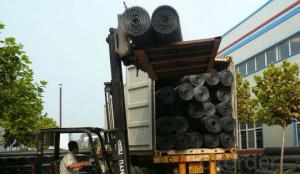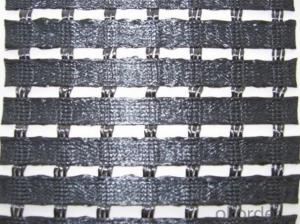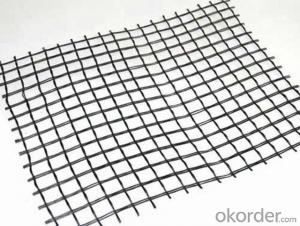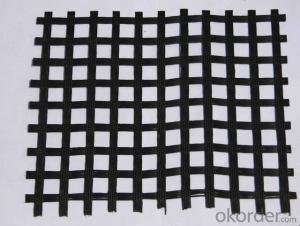Biaxial Water-soluble PVC Coated Polyester Geogrid High Intensity Biaxial Glass-fiber
- Loading Port:
- Qingdao
- Payment Terms:
- TT OR LC
- Min Order Qty:
- 5000 m²
- Supply Capability:
- 2000000 m²/month
OKorder Service Pledge
OKorder Financial Service
You Might Also Like
Specifications of Geogrid:
Biaxial geogrid made from polypropylene polyethylene appears network structure of square. The product us formed after the processes of extrusion, punching, longitudinal and horizontal stretch . This kind of geogrid has high tensile longitudinally and horizontally, which can be used to reinforce the basement.
Applications of Geogrid:
Make reinforce treatment for various kinds of soft soil foundation to evenly distribute load stress and reduce uneven settlement, not easy to generate static electricity, and flammability property good in the coal mine. It is easy to wash coal.
Used in highway, railway, port, airport and municipal project. Support in the recovery working face of coal mine and roadway in the coal mine.
Index Properties | Test Method | Unit | GG1515 | GG2020 | GG3030 | GG4040 |
MD TD | MD TD | MD TD | MD TD | |||
Polymer | -- | -- | PP | PP | PP | PP |
Minimum Carbon Black | ASTM D 4218 | % | 2 | 2 | 2 | 2 |
Tensile Strength@ 2% Strain | ASTM D 6637 | Kn/m | 5 5 | 7 7 | 10.5 10.5 | 14 14 |
Tensile Strength@ 5% Strain | ASTM D 6637 | Kn/m | 7 7 | 14 14 | 21 21 | 28 28 |
Ultimate Tensile Strength | ASTM D 6637 | Kn/m | 15 15 | 20 20 | 30 30 | 40 40 |
Strain @ Ultimate Strength | ASTM D 6637 | % | 13 10 | 13 10 | 13 10 | 13 10 |
Structural Integrity | ||||||
Junction Efficiency | GRI GG2 | % | 93 | 93 | 93 | 93 |
Flexural Rigidity | ASTM D 1388 | Mg-cm | 700000 | 1000000 | 3500000 | 10000000 |
Aperture Stability | COE Method | mm-N/deg | 646 | 707 | 1432 | 2104 |
Dimensions | ||||||
Roll Width | -- | M | 3.95 | 3.95 | 3.95 | 3.95 |
Roll Length | -- | M | 50 | 50 | 50 | 50 |
Roll Weight | -- | Kg | 39 | 50 | 72 | 105 |
MD denotes Machine direction. TD denotes transverse direction. | ||||||
Property of Geogrid:
1.) Improve roadbed bearing capacity,enlarge road lifetime.
2.) Prevent road collapse and crack
3.) Prevent soil and water loss in slope
4.) Could replace steel-plastic geogrid in coal mine.
Geogrid Show:
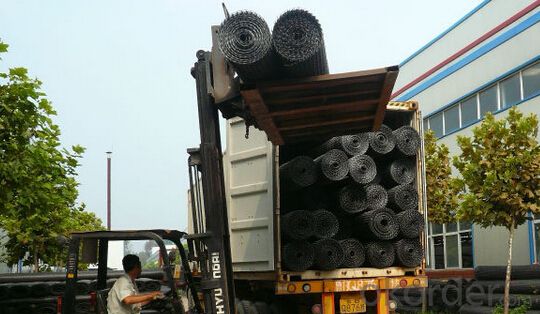
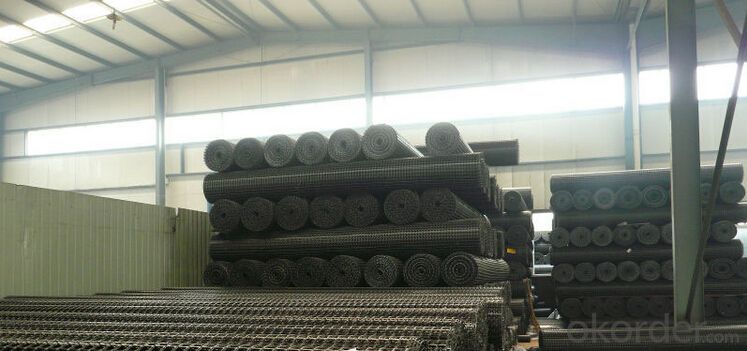
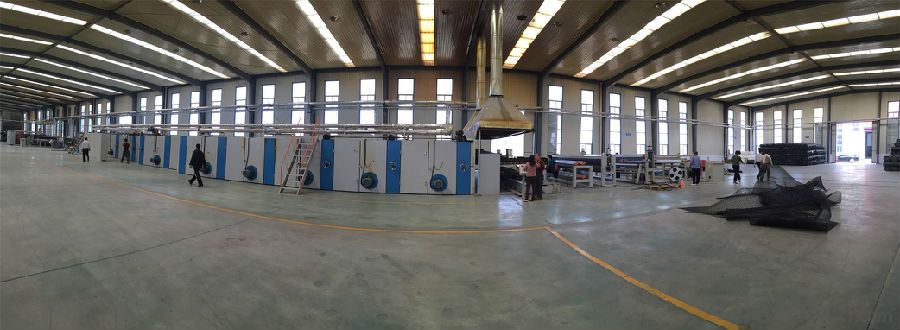
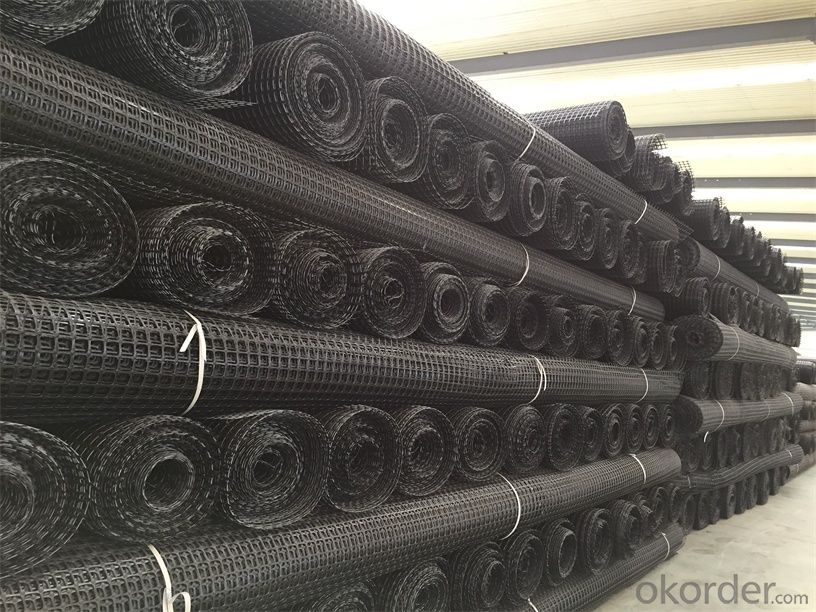
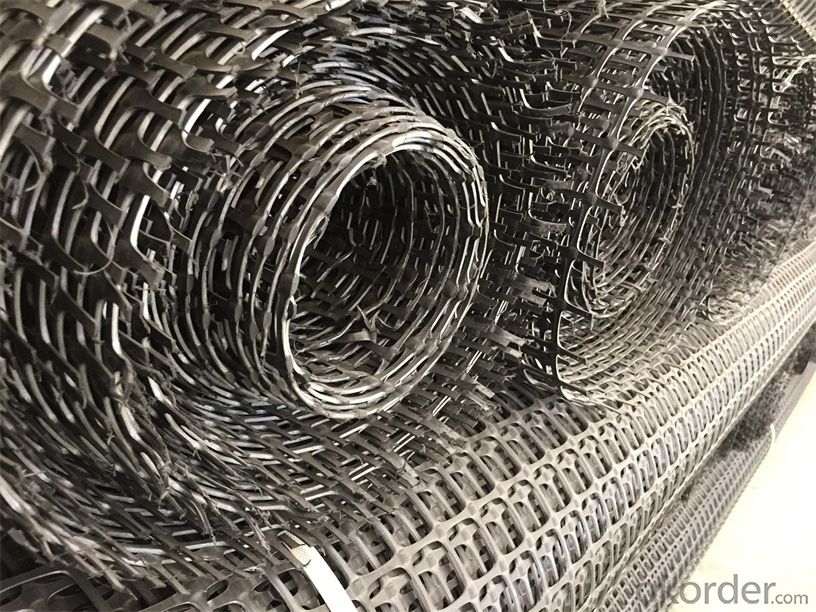
FAQ:
1. How to order your geogrid ?
a). Tensile strength in warp & weft direction
b). Grid size
c). Width and length
d). Quantity
2. Payment term .
a) TT
b) LC AT SIGHT
c) cash
d) 30% contact value as deposit ,the blance 70% be paid after received the copy of bl .
3. Delivery time
a) 19-25 days after received your depsit .
4. What is MQQ ?
a) 2500 m2 as MQQ , we can also produce sample for you .
- Q:What are the different testing methods for geogrids?
- Some of the different testing methods for geogrids include tensile strength testing, aperture size testing, creep testing, and durability testing. Tensile strength testing evaluates the geogrid's ability to resist pulling forces, while aperture size testing measures the size of the openings in the geogrid. Creep testing assesses the geogrid's deformation under constant load over time, and durability testing evaluates its resistance to environmental factors like UV exposure and chemical degradation. These testing methods help determine the performance and suitability of geogrids for various geotechnical applications.
- Q:Are geogrids suitable for reinforcing embankments?
- Yes, geogrids are suitable for reinforcing embankments. Geogrids are specifically designed for soil reinforcement and stabilization purposes. They can effectively distribute loads and improve the stability and strength of embankments, preventing soil erosion and potential failure. Additionally, geogrids are easy to install, cost-effective, and have a long service life, making them a reliable choice for reinforcing embankments.
- Q:How do geogrids improve the performance of reinforced soil retaining walls?
- Geogrids improve the performance of reinforced soil retaining walls by providing additional tensile strength and stability to the structure. They enhance the soil's ability to resist lateral pressures and improve overall load distribution, which ultimately increases the wall's bearing capacity and structural integrity. Additionally, geogrids help prevent soil erosion and displacement, ensuring long-term stability and durability of the retaining wall system.
- Q:Can geogrids be used in bridge construction?
- Yes, geogrids can be used in bridge construction. Geogrids are commonly employed to reinforce the soil beneath bridge foundations, providing stability and enhancing load-bearing capacity. They can also be utilized in bridge abutments and retaining walls to prevent soil erosion and improve overall structural integrity.
- Q:Can geogrids be used in stabilization of river training structures?
- Yes, geogrids can be used in the stabilization of river training structures. Geogrids are commonly used in civil engineering to reinforce soil and provide stability to various structures. In the case of river training structures, geogrids can be installed to reinforce the banks and prevent erosion, thus improving the overall stability of the structure.
- Q:How do geogrids help in reducing construction costs?
- Geogrids help in reducing construction costs by providing reinforcement to soil and improving its stability, which eliminates the need for expensive excavation and replacement of weak soil. They also allow for the use of less expensive and locally available fill materials, reducing the need for transportation and disposal costs. Additionally, geogrids help in the construction of thinner and lighter structures, reducing the amount of expensive construction materials required.
- Q:Do geogrids require maintenance?
- Yes, geogrids do require maintenance. Routine inspection is necessary to ensure their proper functioning and longevity. This may involve checking for any signs of damage, such as tears or punctures, and addressing any issues promptly. Additionally, regular cleaning and removal of debris is important to prevent clogging and maintain the effectiveness of geogrids. Overall, proper maintenance helps to extend the lifespan and performance of geogrids in various applications.
- Q:How to ensure the quality of geogrid laying?
- The geogrid laying quantity and not according to the design, inspection group of misrepresentation. "Said simply is not according to the standard of laying geogrid, geogrid using standard reasons for the decline, Jerry was to" per square meter can save about 20 Fen, part of the investment funds also led to this events. The quality problems of railway construction, which relates to the future railway service life and quality
- Q:Can geogrids be used in ground reinforcement for airports?
- Yes, geogrids can be used in ground reinforcement for airports. Geogrids are commonly used to enhance the stability and load-bearing capacity of soil, making them suitable for reinforcing airport runways, taxiways, and aprons. They help distribute the load, reduce soil movement, and improve overall pavement performance, ensuring a safer and more durable infrastructure for airports.
- Q:Can geogrids be used in slope stabilization?
- Yes, geogrids can be used in slope stabilization. Geogrids are commonly used in slope stabilization projects as they provide reinforcement and enhance the stability of soil and slopes. They help distribute loads, increase soil shear strength, and prevent soil erosion. Geogrids are effective in stabilizing slopes and preventing landslides, making them a suitable solution for slope stabilization.
1. Manufacturer Overview |
|
|---|---|
| Location | |
| Year Established | |
| Annual Output Value | |
| Main Markets | |
| Company Certifications | |
2. Manufacturer Certificates |
|
|---|---|
| a) Certification Name | |
| Range | |
| Reference | |
| Validity Period | |
3. Manufacturer Capability |
|
|---|---|
| a)Trade Capacity | |
| Nearest Port | |
| Export Percentage | |
| No.of Employees in Trade Department | |
| Language Spoken: | |
| b)Factory Information | |
| Factory Size: | |
| No. of Production Lines | |
| Contract Manufacturing | |
| Product Price Range | |
Send your message to us
Biaxial Water-soluble PVC Coated Polyester Geogrid High Intensity Biaxial Glass-fiber
- Loading Port:
- Qingdao
- Payment Terms:
- TT OR LC
- Min Order Qty:
- 5000 m²
- Supply Capability:
- 2000000 m²/month
OKorder Service Pledge
OKorder Financial Service
Similar products
New products
Hot products
Hot Searches
Related keywords
